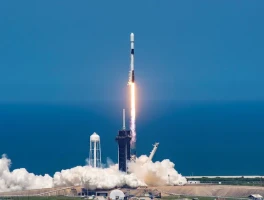Okay, folks, buckle up, because what SpaceX pulled off this week wasn't just a couple of launches; it was a symphony of precision, a ballet of engineering, and, dare I say, a sneak peek into a future where reaching for the stars is as routine as catching a flight across the country. I mean, two Falcon 9 rockets, soaring into the heavens within four hours of each other? That's not just impressive, it's a paradigm shift.
It all started Friday night, with a Falcon 9 carrying 29 Starlink satellites blasting off from Kennedy Space Center. A flawless mission: the first stage landing gracefully on the drone ship, "A Shortfall of Gravitas," the satellites deployed into low Earth orbit less than an hour later. Then, just a few hours later, another Falcon 9, carrying another 29 Starlink satellites, thundered into the sky from Cape Canaveral. Another perfect landing, another successful deployment. The sheer scale of this operation is breathtaking.
The New Normal?
But let's zoom out for a second. This wasn't just about putting more satellites in orbit. This was about demonstrating a capability, a rhythm of space access that was previously the stuff of science fiction. Think about the early days of aviation: rickety biplanes, daring pilots, and a whole lot of uncertainty. Now, imagine trying to explain the concept of a modern airport to someone from that era. That’s the kind of leap we're talking about here.
And let's not forget the launch from Vandenberg Space Force Base in California! While everyone was focused on the double launch in Florida, SpaceX was also preparing to send a government weather satellite, Sentinel-6B, into orbit to monitor rising sea levels. The satellite will measure sea levels and record atmospheric temperatures, taking over the work of its predecessor twin satellite. This launch is the first from California under a new FAA curfew restricting launches to between 10 p.m. and 6 a.m. local time. It's incredible to see how SpaceX is adapting to new regulations and continuing to push the boundaries of what's possible. More on the upcoming launch can be found in SpaceX plans rocket launch from Vandenberg. Where to see liftoff in California.
What does it mean? It means that access to space is becoming democratized. It means that the cost of reaching orbit is plummeting. It means that the dreams of scientists, engineers, and entrepreneurs are no longer bound by the limitations of yesterday. And then Blue Origin successfully launched its New Glenn rocket from Florida, successfully landing the reusable booster. Until now, Elon Musk's SpaceX had been the only one to accomplish this feat. Is this the start of a new space race?

These launches are the 145th and 146th Falcon 9 missions of the year for SpaceX. More than 100 of these flights have been devoted to building out the Starlink megaconstellation. There are currently more than 8,900 operational Starlink satellites in LEO, and the number is growing all the time. It's a testament to the relentless pace of innovation that SpaceX has cultivated.
It's easy to get caught up in the technical details, but I think the real story here is about the human spirit. It's about our innate desire to explore, to innovate, to push the boundaries of what's possible. These launches are a reminder that we are capable of achieving incredible things when we set our minds to it. What kind of new technologies will be developed in space? What resources will we discover? What new understanding of the universe will we gain?
I saw a comment on a Reddit thread that really stuck with me: "This isn't just about rockets; it's about building the infrastructure for a future where humanity is no longer confined to a single planet." Isn't that the most inspiring thing you've ever heard?
But with great power comes great responsibility. As we venture further into the cosmos, we must do so with humility, with respect, and with a commitment to protecting the fragile beauty of our universe. We must ensure that the benefits of space exploration are shared by all, not just a select few. How do we ensure that space exploration benefits all of humanity? How do we prevent the weaponization of space? These are questions we must grapple with as we move forward.
Space: The Final Economic Frontier
These aren't just launches; they're the opening salvos in a new space-based economy. Imagine a future where satellites provide ubiquitous internet access, where resources are mined from asteroids, where manufacturing takes place in the unique environment of space. The possibilities are truly endless.
So, What's the Real Story?
This isn't just about rockets; it's about the dawn of a new era for humanity, an era where the stars are within our reach.

